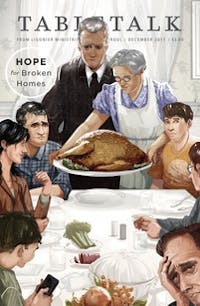
Request your free, three-month trial to Tabletalk magazine. You’ll receive the print issue monthly and gain immediate digital access to decades of archives. This trial is risk-free. No credit card required.
Try Tabletalk NowAlready receive Tabletalk magazine every month?
Verify your email address to gain unlimited access.
In 1948, the famous Harvard social historian Pitirim Sorokin wrote an essay in which he sounded an alarm about the rapid disintegration of the stability of the American culture. In this essay, Sorokin pointed out that in 1910 the divorce rate in America was ten percent. Yet from 1910 to 1948, the rate of divorce in America escalated from ten to twenty-five percent. Sorokin indicated that if a quarter of the homes in any given nation are broken by divorce, the stability of the nation cannot endure. Its culture is torn to shreds. Arguing that the family unit is the most basic and foundational unit of every society, he said that when that unit breaks, the society itself suffers a shattered continuity.
One wonders what Sorokin would think if he observed the situation that exists in America today. Since 1948, the divorce rate has gone from twenty-five percent up to and beyond fifty percent: that is, at least half of those marriages that are contracted in America end in divorce. This also means that at least half of the families that are united by marriage suffer a fracture; in a word, they are broken.
The fallout from this startling statistic includes the growing disenchantment with the institution of marriage itself in unprecedented numbers. From the beginning of time and the institution of marriage by God in the garden of Eden, matrimony has been pursued by nearly everyone. However, many people are now eschewing marriage and are choosing cohabitation without the covenant bond of marriage. This situation is not only dangerous but, from a biblical perspective, involves gross and heinous sin. Cohabitation without marriage is seen by God as sexual immorality.
Obviously, the majority in America is not concerned about departure from a biblical ethic. But what is even more disconcerting is that many young people who are members in good standing of evangelical Christian churches opt for cohabitations without fear of rebuke or discipline from church authorities. This says as much about the church as it does the people who are living in wanton sin. In addition to those cohabitating outside of marriage, we also see a multitude of young women who choose to be single parents without entering into marriage or even without cohabitating with the fathers of their children. The single mother is becoming almost an institution in American culture. This spells a serious situation of brokenness that affects the very fabric of American society.
The issue of divorce can be measured objectively by simply examining the statistics of marriages and dissolutions of marriages that are accomplished legally. But in addition to this objective statistic, we find other forms of brokenness within the context of marriage. It is not only divorce that breaks a home; when parents are addicted to illicit drugs or abuse other substances, the family structure is equally broken. The threat to the family unit is ultimately a manifestation of the fallenness of our human nature. Sin violates family unity. Sin is the force by which families are broken. And sinners have no power within themselves to repair that which is broken. The broken home seems to suffer a fate similar to Humpty Dumpty. All the king’s horses and all the king’s men were not able to repair the fracture that this poor mythical egg experienced.
The number of people seeking to survive within the context of brokenness has now reached multiple millions. The comforting factor is that if we are involved in such brokenness, our experience is not unique, anomalous, or something that takes place in solitary confinement. Rather, those of us who are involved in broken homes are surrounded by multitudes experiencing the same pain due to the dissolution of family stability. This is an area, of course, that not only asks for but screams for the church’s ministry.
The New Testament puts a priority on the church’s concern for widows and orphans. Widows and orphans are human beings who have suffered broken families not through divorce but through death. Obviously, the church’s concern must extend beyond those whose brokenness has been caused by death. Anyone who is involved in a broken family relationship needs the ministry and care of the church. One good thing that has come out of this destruction of the American family is the church’s awakening to the need to minister to single mothers and fathers, to recovering substance abusers, and to all who are trying to repair their lives after going through difficult divorces. Divorce can no longer be seen simply as an extreme case of marital failure. Since it has reached not only epidemic but pandemic proportions, it cries out for the application of the means of grace to those who suffer as a result of it.
A church that closes its doors and its hearts to those who are in broken situations cannot be considered a church at all. The church exists, principally, to minister to those who are broken. It was said of our Lord Himself that He would not break the bruised reed (Isa. 42:3). Victims of broken homes are bruised people; the bruises will not go away without help. This is a wound that time does not have the capacity to heal. It requires the healing of God Himself, which He often ministers through His church. This is our concern as Christians, and one we dare not neglect. How we handle these situations will have an eternal impact, not only for the individuals involved, but for cultures and nations whose structure is marred by brokenness.
